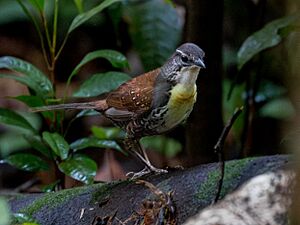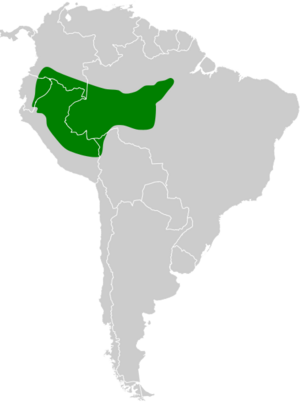Rusty-belted tapaculo facts for kids
Quick facts for kids Rusty-belted tapaculo |
|
|---|---|
 |
|
| Liosceles thoracicus thoracicus, Pará, Brazil | |
| Conservation status | |
| Scientific classification | |
| Genus: |
Liosceles
|
| Species: |
thoracicus
|
 |
|
| Synonyms | |
|
Pteroptochus thoracicus P. L. Sclater, 1865 |
|
The rusty-belted tapaculo (Liosceles thoracicus) is a small, unique bird. It belongs to a group of birds called passerines, which are often known as "perching birds." This bird is the only one of its kind in the Liosceles genus. You can find the rusty-belted tapaculo in parts of Brazil, Bolivia, Colombia, Ecuador, and Peru.
Contents
About the Rusty-Belted Tapaculo's Name
The rusty-belted tapaculo is the only species in its group, or genus. A scientist named Philip Lutley Sclater first described this bird and its genus in 1865.
There are three slightly different types, called subspecies, of the rusty-belted tapaculo:
- Liosceles thoracicus thoracicus (the main type)
- L. t. dugandi
- L. t. erithacus
What the Rusty-Belted Tapaculo Looks Like
The rusty-belted tapaculo is about 19.5 cm (7.7 in) long. It weighs between 39 to 42 g (1.4 to 1.5 oz), which is about as much as a few pieces of candy. Its feathers look different from other tapaculo birds.
The main type of this bird has a grayish-brown head. It has a white stripe above its eye, called a supercilium. Its back, wings, and rump are reddish-brown. The bird's throat is white with black lines on the sides. Most of its chest is white. Its sides and bottom are striped with black, brown, and white.
The most special part is a yellow to orange-brown band on its upper chest. This band is what gives the bird its "rusty-belted" name!
- The L. t. erithacus subspecies has a browner head. Its chest band is bigger and darker.
- The L. t. dugandi subspecies is similar to the main type. But its chest band is more reddish-brown and goes up into its neck and throat.
This bird makes sounds from the ground or low tree branches. Its song is a simple whistle that repeats. It often ends with a series of notes that go lower. Its call sounds like a repeated "cree" or "cree-cree."
Where the Rusty-Belted Tapaculo Lives
The main type of rusty-belted tapaculo lives in western and central Amazonian Brazil. Scientists think this type also lives in southeastern Peru and northern Bolivia. The L. t. dugandi subspecies lives in southeastern Colombia and nearby western Brazil. The L. t. erithacus subspecies is found in eastern Ecuador and eastern Peru.
This bird is special because it's the only tapaculo that lives in the Amazonian rainforest. It mostly lives in humid terra firme forests. These are forests where the ground stays dry all year. But it can also live in várzea forests, which get flooded during certain seasons.
It usually lives at elevations up to 600 m (2,000 ft). In some places, it can be found up to 900 m (3,000 ft). In Peru, it has been seen as high as 1,000 m (3,300 ft).
Rusty-Belted Tapaculo Behavior
What the Rusty-Belted Tapaculo Eats
The rusty-belted tapaculo mainly eats small insects called true bugs, which are a type of Hemiptera. It finds its food by walking and hopping on the forest floor. It picks bugs off the leaves and other things on the ground. It also looks for food along fallen tree trunks.
Rusty-Belted Tapaculo Reproduction
We don't know much about how the rusty-belted tapaculo raises its young. Only one nest has ever been found! This nest was shaped like a ball. It was made from small branches, grass, and other plant materials. The nest was on the ground, hidden among the roots of a small tree.
Rusty-Belted Tapaculo Population Status
The IUCN (International Union for Conservation of Nature) has looked at the rusty-belted tapaculo. They have decided it is a species of "Least Concern." This means that its population is not in danger right now.
Even though we don't know the exact number of these birds, scientists believe there are many of them. Their population seems to be stable. The rusty-belted tapaculo also lives in several large areas that are protected.


